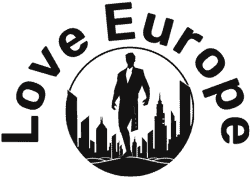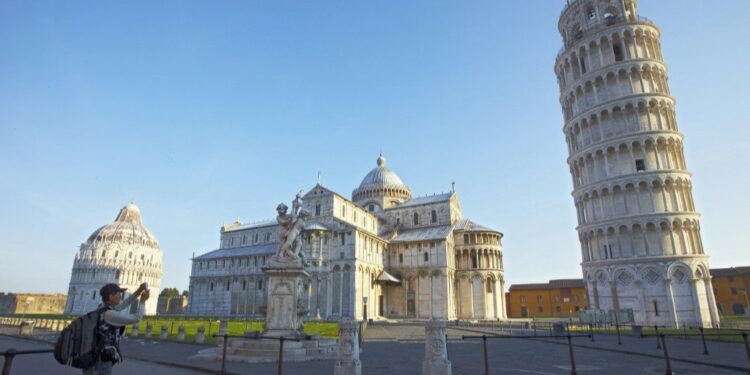Interestingly, the architectural record points to the existence of Muslim communities across medieval Europe.
These communities “thrived, their skills in high demand, as well-paid and well-respected members of society”.
Darke is explicit about the significance of her work and its relevance to contemporary politics.
“In today’s world of shrinking horizons and narrow nationalisms,” she writes, “it is more important to understand how closely interwoven the world’s cultures are.”
This is especially the case given the “undercurrents of Islamophobia that are all too prevalent across Europe”, she argues.
Sure enough, every page of Islamesque would be a source of discomfort for the European far right, whose political parties, Darke asserts, must realise that “their very civilisation was built on the superior skill of immigrants”.
Influx of Arab craftsmen
Romanesque, the hugely important architectural style that paved the way for Gothic, emerged between the years 1000 and 1250 in multiple European countries.
Characterised by innovative vaulting techniques, decorative frames, blind arcades and sculptures of fantastical beasts, it was the “first pan-European architectural style since imperial Roman architecture”.
The term Romanesque means “in the manner of Romans” but Darke argues Romanesque could better be understood as “Islamesque”.
Her thesis is convincing, in the eyes of this author.
Evidently, a change is needed and Islamesque could be the book to bring it about.
As Christian Europe became wealthier, and the Church and nobility had more money to spend on expensive construction projects, there was an influx of highly-skilled Arab craftsmen, artists, sculptors and master builders into the continent.
They were simply the best at the job and quite willing to work for Christian masters.
It’s well-known that Sicily, ruled for centuries by Arab Muslims and then Normans, boasts an extraordinary legacy of medieval Arab-Norman architecture.
Darke explains, however, that Sicily was also a “stepping stone, enabling these talented Muslim artisans to enter Europe and to work on high-level projects”.
The Palatine Chapel in Palermo is one of Sicily’s Arab-Norman masterpieces (Fintan Corrigan/Creative Commons 4.0)
Islamesque is everywhere in mainland Italy. Consider the Leaning Tower of Pisa (1173) with its intrinsic geometry, columns and decorations, which “bear the hallmarks of the typical elegant Islamic aesthetic”. A tell tale sign of Arab influence.
Then there was Spain, where the anti-Muslim persecution of the Reconquista and Inquisition is well known.
Less understood is that there was a remarkable degree of co-existence in many regions, especially Aragon, Navarre and Valencia.
Muslims there were often propertied and prestigious, and regarded as a “legitimate and permanent feature” of society.
Islamesque in western Europe
The most intriguing chapters of the book are the ones that look at Germany, France and the British Isles, where the Islamic architectural influence is least understood.
In each country Darke explores myriad case studies. For example, one of four surviving medieval painted wood ceilings in Europe is in St Michael’s Church in Hildesheim, northern Germany.
Many of the features are evidently Islamic in inspiration.
In France, the English king, Richard the Lionheart employed Arab builders, so that the town of Les Andelys by the Seine still has distinct “Islamic echoes”.
This includes houses with multiple arches and “winding narrow streets casting shade and giving privacy”.
There are many more examples in France. Le Puy Cathedral in the Auvergne, with its black and white arches and facades, “is so heavily influenced by Islamic architecture that even the French acknowledge it”.
The Arabic expression “Al-mulk lillah” (Sovereignty belongs to God) is inscribed on its doors, which leaves little room for doubt.
The Normans are central to the whole story, as they learnt the Islamic style in Sicily, Italy and Spain. They made extensive use of intersecting arches and arcades, as well as geometric patterns and zigzags, which were previously unknown in European architecture.
“Every Norman church and cathedral in the British Isles”, as well as many other buildings, stand testament to Islamic influence, Darke argues.
Thus we learn that Castle Rising (1138) in Norfolk is “modelled on Islamic pleasure palaces-cum-hunting lodges”.
The keep of the Tower of London, built under William the Conqueror in 1078, exhibits a clear Islamic influence in its arched windows.

Diana Darke writes that Castle Rising in Norfolk is ‘modelled on Islamic pleasure palaces-cum-hunting lodges’ (Sandy Gerrard/Creative Commons)
Twelfth-century Bristol Cathedral was founded by an Anglo-Saxon merchant and has an interior heavily decorated with zigzags.
Darke concludes that the best available evidence suggests it could only have been built by Arabs.
It’s the same story with multiple other cathedrals, like Salisbury, built centuries later in the early fourteenth century.
Darke examines Arabic numerals carved into its roof timber beams.
“The sudden simultaneous appearance of fantastical beasts, arabesques and geometric patterns in so-called Romanesque buildings across England at this time,” Darke writes, “clearly points to the Arab Fatimid influences acquired by the Normans in Sicily.”
The tourists who flock every weekend to Durham Cathedral in the north of England will find it full of marvellous sculptures of foliage, strange faces and fantastical creatures.
They were made between 1093 and 1133 by Muslim masons, who had been captured by a Norman crusader knight in the Middle East.

The heritage of Notre Dame – less European than people think
Read More »
The village church at Kilpeck in Herefordshire is likewise decorated with fantastical creatures, including a “kind of cross between serpents and dragons”.
These bear the clear imprint of the Fatimid style, as they’re not spiritually focused decorations, but more like an “homage to Nature”.
Even those who typically find architectural history dull are likely to receive a thrill at many of Darke’s revelations.
Islamesque is a stunning achievement and a greatly significant piece of work.
By illuminating a forgotten history of Muslims in medieval Europe, and their achievements and legacy, Darke points to a new way of thinking about the often-maligned Muslim presence in the continent today.
The Renaissance-era painting on the book’s cover depicts St Benedict with a retinue of monks and brown-skinned (often Arab or African) craftsmen constructing monasteries, apparently Arab or African.
“Five hundred years ago, there was not, it seems, any attempt to disguise the identities of the craftsmen.” Darke write.
Now, Darke notes, there is a campaign afoot to distance Europe from its “Muslim legacy”.
Souvenir shops in medieval tourist hotspots, particularly in France or Spain, sell material that depict almost only European-looking medieval figures, which she says is a distortion of history.
Evidently, a change is needed. Islamesque could be the book to bring it about.
Source link : http://www.bing.com/news/apiclick.aspx?ref=FexRss&aid=&tid=67814af5ebcb42cab90e5e61e709afcf&url=https%3A%2F%2Fwww.middleeasteye.net%2Fdiscover%2Fhow-muslim-migrants-built-medieval-europes-castles-churches-and-monasteries&c=4229733742763019847&mkt=de-de
Author :
Publish date : 2025-01-10 03:05:00
Copyright for syndicated content belongs to the linked Source.




